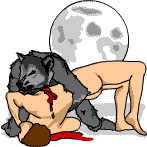Werewolves
Created | Updated Nov 11, 2011

Throughout mankind's social development and culture, the wolf, the moon and hunting have been intertwined in a complex mythology resulting in the phenomenon known as the werewolf.
Early Mythology
In early times, tribal hunters wore bear and wolf hides in the belief that they imbued strength and courage to the wearer while in combat. Around the 15th Century, the myths concerning men and wolves continued apace. Many believed that a man could physically become a wolf just by wearing its 'magical' hide or a belt made from wolf skin. However, it's also quite likely that a combination of drugs and hypnosis could have made men believe they were turning into a wolf.
This early werewolf mythology is also closely related to a bizare psychological condition called Lycanthropy which causes the sufferer to believe they can become a wolf. In many cases their belief is so strong that they end up attacking and killing others.
Lycanthropy was recognised as an illness as early as the 2nd Century - many supposed werewolves were classed as Lycanthropes when they were put on trial. However, they were rarely set free, and often they were hanged.
Werewolf Folklore
Werewolf folklore has incorporated many other ideas and stories, such as the werewolf's relationship with the moon1. This connection is believed to have started at around the same time as the domestication of dogs, when their owners would observe their animals howling for hours at the full moon.
As knowledge of werewolves - or the idea of werewolves - became widespread, theories were put forward as to who would became a werewolf. Children born with unusual markings and abnormal hair growth were singled out to become werewolves and in some cases even children born feet first were said to be cursed. The myth progressed to the point that anyone could become a werewolf through such things as drinking from the same water source as a wolf, eating a wolf or even eating a sheep that had been killed by a wolf. Savage behaviour, aggressiveness and a tendency to lash out and bite others are the trademark symptoms shown by victims of rabies, and such cases would have easily added to the werewolf folklore, particularly as rabies was commonly spread by wild animals to humans through bites and saliva. In this respect, there is a strong link between werewolf and vampire mythology. As local fear grew, villagers hung wolfsbane2 at their doors in a vain attempt to keep the evil at bay and secure them peace of mind at night.
Thanks to Hollywood however, the werewolf myth still lives on and, like its vampire counterpart, has become a slick, sexually-active creature.
For more on werewolves and related topics, see h2g2's Fortean entry on unexplained phenomena.

